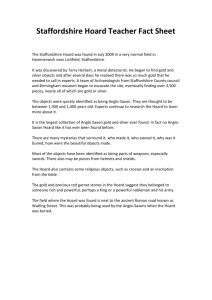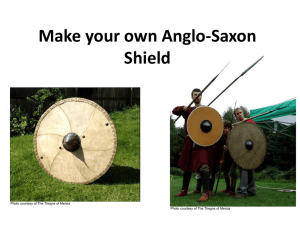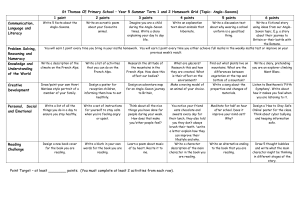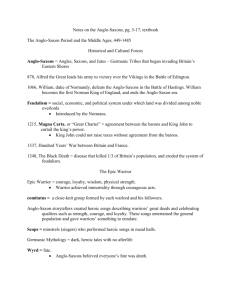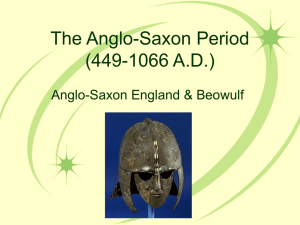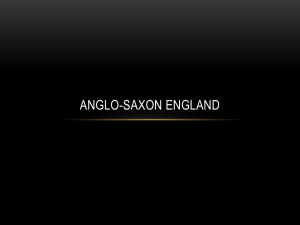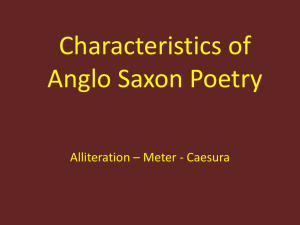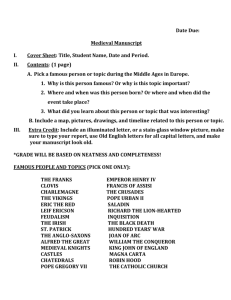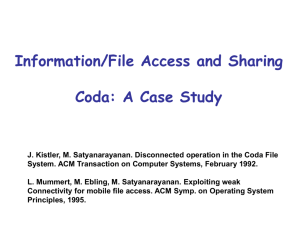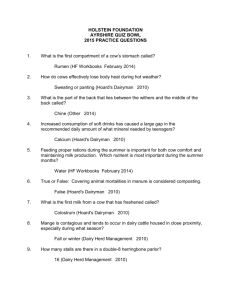Exhibition Education Scheme of Work
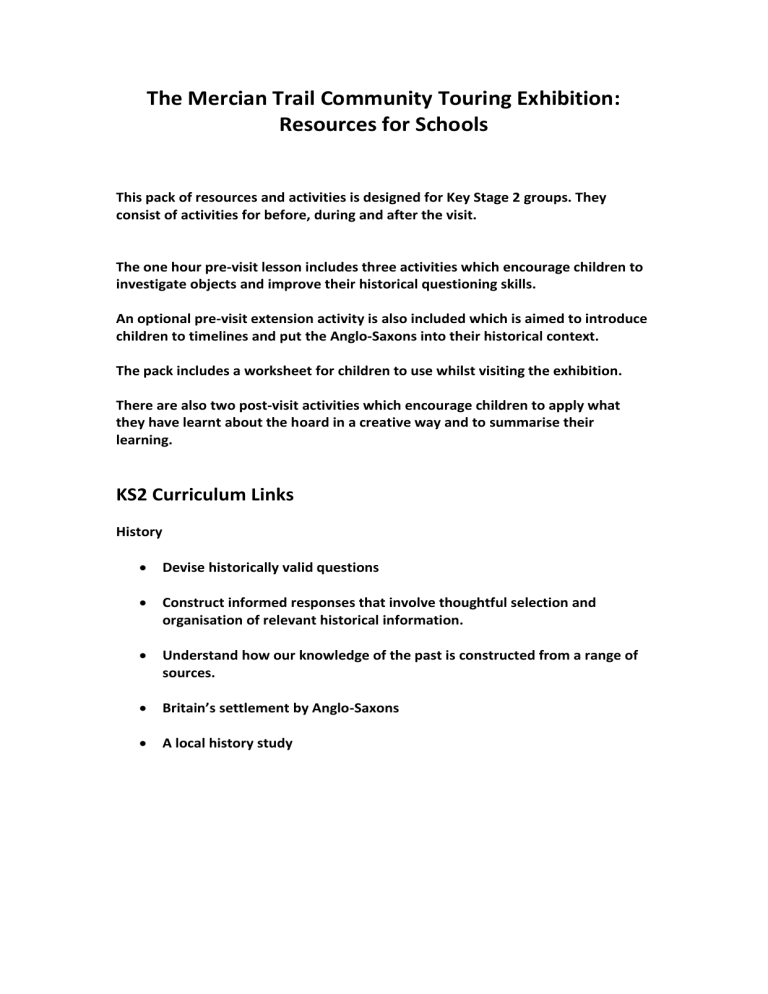
The Mercian Trail Community Touring Exhibition:
Resources for Schools
This pack of resources and activities is designed for Key Stage 2 groups. They consist of activities for before, during and after the visit.
The one hour pre-visit lesson includes three activities which encourage children to investigate objects and improve their historical questioning skills.
An optional pre-visit extension activity is also included which is aimed to introduce children to timelines and put the Anglo-Saxons into their historical context.
The pack includes a worksheet for children to use whilst visiting the exhibition.
There are also two post-visit activities which encourage children to apply what they have learnt about the hoard in a creative way and to summarise their learning.
KS2 Curriculum Links
History
Devise historically valid questions
Construct informed responses that involve thoughtful selection and organisation of relevant historical information.
Understand how our knowledge of the past is constructed from a range of sources.
Britain’s settlement by Anglo-Saxons
A local history study
Pre-Visit Lesson
Learning Objectives: To learn some basic facts about the Staffordshire Hoard
To learn how to form questions and investigate objects to discover something about the past
To discover who the Anglo-Saxons were.
Differentiation: Higher ability children will be able to form more complex questions.
Activity 1: Mystery Objects
Resources: Mystery objects ppt.
Objects fact sheet
The purpose of this activity is to encourage the students to think about investigating objects, asking questions and learning how objects can tell us about the past.
Explain to the children that they are going to be learning about some very interesting treasure from a long time ago. To do this they need to start by asking lots of questions.
Show them the first of the three mystery objects using the Mystery Objects powerpoint. Explain to them that you will not tell them what the object is. They need to find out by asking questions about it. Invite questions from the class, if they are appropriate reveal answers until they work out what object 1 is.
Questions could include:
What is the object made of?
How old is the object?
Who did the object belong to?
How big is the object?
Split the class into small groups, reveal the second mystery object. Explain that this time each group must decide three questions to ask to find out what object 2 is.
After 5 minutes ask each group to feedback and discuss their choices.
Reveal object three. Ask the whole class to debate which three questions should be asked to find out what the object is. Object 3 can be linked into the next activity by explaining that it is Anglo-Saxon.
Activity 2: Introducing the Anglo-Saxons
Resources: Introducing the Anglo-Saxons ppt.
Anglo-Saxon True or False sheet
Anglo-Saxon True or False sheet with answers
Explain that the students are going to be learning more about this mysterious people. Ask the students if they know anything already about the Anglo-Saxons.
Use the introducing the Anglo-Saxons ppt. And fact sheet to explain some initial information about the Anglo-Saxons.
Split the class into pairs. Give each pair a copy of the Anglo-Saxon True or False sheet and ask them to discuss and then write and answer for each. Discuss their answers
Activity 3: The Mystery of the Staffordshire Hoard
Resources: Staffordshire Hoard ppt.
Staffordshire Hoard teacher fact sheet
Using the Staffordshire Hoard teacher fact sheet tell the story of the Staffordshire
Hoard and what we know so far about it.
Explain that there are many mysteries surrounding the Staffordshire Hoard and ask the children what they think they might be.
In small groups ask the children to come up with three questions they would ask the hoard if it could talk. Feedback to the class and discuss.
Pre-Visit Extension Activity
Timelines
Learning Objectives: To learn when the Anglo-Saxons existed
To understand how to make a timeline
Curriculum Links: Develop understanding of time
Subtraction of 4 digit numbers
Resources: Timelines ppt.
Time lines facts
Timelines questions
Timelines answer sheet
Ask the Children to stand in a row and put themselves in order of their birthdays
(this will require enough space for the whole class to stand in a line). Explain that the students have made a timeline based on their date of birth.
Split the class into pairs and give each pair a set of the timeline facts. Ask them to cut out the facts and put them in order of when they think they happened.
Fewer facts can be used to reduce the length of the activity.
Discuss the date order of the timeline facts.
With the timeline dates on the board ask the children to work out the timeline questions and discuss answers.
Post visit Activities
Activity 1: The Lost Manuscript
Objectives: To express own ideas about why the Staffordshire
Hoard was buried.
Resources: Lost Manuscript ppt.
Lost Manuscript worksheet
Using the Lost Manuscript ppt. slide ask the children about what they learn by visiting the exhibition.
Introduce the pupils to what a manuscript is and explain that the Anglo-Saxons wrote down their own history but some were lost. Explain that manuscripts had beautifully decorated letters at the beginning of some pages known as illuminated letters.
Explain that you want the children to imagine they are an Anglo-Saxon who has been asked to write down the story of what happened to the Staffordshire Hoard.
Introduce students to the Lost Manuscript worksheet. Ask them to write out their story of how the Hoard came to be buried and explain that when they finish they can decorate the manuscript with their own illuminated letter.
Activity 2: Anglo-Saxon Shields
Objectives: To think about how objects can have a meaning or purpose
To design their own shield
Resources: Anglo-Saxon shield ppt.
Anglo-Saxon shield worksheet
Card for making a shield
Using the Anglo-Saxon Shield ppt. explain that some objects in the Staffordshire
Hoard were probably used to decorate shields. Ask the students why they think the Anglo-Saxons did this.
The mythical creatures and fierce animals may have been symbolic and could have been to frighten enemies. The rich gold objects would also have been to show how rich and powerful they were.
Explain to the children that they are going to design their own shield, but they need to think carefully about what they are going to put on their shield, what will it tell people about them?
When they have made their shield ask the children to write what they have learnt about the Staffordshire Hoard on the back.
